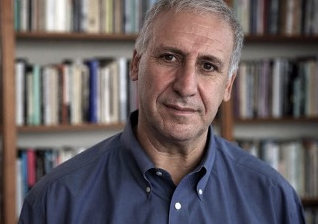Polish Poetry Unites is a video series complementing our Encounters with Polish Literature series for anyone interested in literature, poetry in particular, history, and reading. In each episode, Edward Hirsch, a distinguished American poet, and the president of the Guggenheim Memorial Foundation, will introduce a celebrated Polish poet to American audiences.
Anna Świrczynska (Swir) would have been 114, had she been still alive. She would probably be surprised that her voice from over half a century ago is still heard in the world, and even more in the world than in her native Poland. She represented a free spirit of feminism without a drop of anger, some people say, and her ideas are still appealing to many feminists and women in general who do not necessary think of themselves as feminists.
“Anna Świrczynska is a remarkable poet. She was born in 1909 in Warsaw. She’s of the same generation as Czesław Miłosz. Her father was a painter. They were very poor. Her father must have been eccentric too, because in her poems she often refers to him as the madman. Her mother was a beauty, and she often says that her– that beauty married a madman.” That’s how Edward Hirsch starts his introduction. Then he continues: “She was affected by the poverty of her early life, but she was really deeply changed and affected by World War II and the occupation of the Nazis. She was in the Warsaw Uprising. She was a military nurse, and she wrote for resistance magazines.
It took her 30 years to write about the Warsaw uprising, and she wrote this incredible little book called “Building the Barricade”. They’re mostly little prose poems about the Warsaw uprising and I recommend them to you highly.“
Anna Świrczynska’s book of poems “Talking to My Body” was translated into English by Czesław Miłosz and Andrew Nathan and published in the US in 1987. It was her first volume that appeared in English. The second one was a collection called: “Building The Barricade and Other Poems,” and was published in the States in 2011 in Piotr Florczyk’s translation.
Jenny Holzer, a leading neo-conceptual artist based in New York, used Anna Świrczynska’s poetry in her installation in the Guggenheim Museum in Bilbao recently. In part two of this video a Columbia University student talks about Anna Świrczynska’s poem, “The Same Inside,” which became her favorite.
“Anna Świrczynska writes about being a woman with tremendous frankness, but also in extremely interesting ways she writes a lot about her body, but her book is called ‘talking to my body’,” said Edward Hirsch. “And what’s really striking about her is there’s a sense both of having, inhabiting a female body and writing about women’s experience.
But also, there’s the experience of being somewhat separate from your body, of talking to your body in a somewhat objective way. There’s some very funny poems or moments in her poems where she’ll go “I went to the corner, and I turned left. I wonder what would have happened if my body went to the right or if my person went to the right”. It’s very odd the way she talks about it and very, very, very lively. But it’s… it’s– it’s really very dramatic, the way she writes about personal experience.”
In the poem– In the film you’re gonna see she writes about encountering a beggar woman, and what that’s like for her. But what’s striking also is the– what… The person in the film doesn’t mention is that it’s part of a… the poem is part of a section of poems called–” Felicious Love”.
In these poems she describes different women, and she takes the view of different women So it’s not just one woman it’s the perspective of a whole various group of women. And it’s really that experience of what it’s like to be a woman and dramatized through a lot of different voices that makes her work so unique and extraordinary.
Anna Świrczynska’s poetry deals with the world of women in such a powerful and energetic way, that after almost half a century after her death it still feels original and inspirational.”
Not many people know that Anna Świrczynska was also a very talented artist. Her best drawings, needless to say, are those that depict female bodies. In the video we show samples of her artwork.
In the second part of the Polish Poetry Unites video, Tatiana de Dalmas, a student at Barnard College in NYC, talks about her life in the prism of her favorite poem by Anna Świrczynska: “The Same Inside”.
The Same Inside
by Anna Świrszczyńska
En route to a love feast with you,
on the corner I saw
an old beggar woman.
I took her by the hand,
kissed her soft cheek,
we talked, she was
the same inside as I,
of the same breed.
I felt it right away,
like a dog sniffing out
another dog.
I gave her money;
I couldn’t part from her.
After all, one needs
someone who is close.
And then I no longer knew
why I was going to you.
Translated from the Polish
by Joanna Trzeciak Huss
Taka sama w środku
Anna Świrszczyńska
Idąc na ucztę miłosną do ciebie
zobaczyłam na rogu
starą żebraczkę.
Wzięłam ją za rękę,
pocałowałam w delikatny policzek,
rozmawiałyśmy, ona była
taka sama w środku jak ja,
z tego samego gatunku,
poczułam to od razu,
jak pies poczuje węchem
psa drugiego.
Dałam jej pieniądze,
nie mogłam się z nią rozstać.
Człowiekowi potrzebny przecież
ktoś bliski.
I potem już nie wiedziałam,
po co ja idę do ciebie.
Anna Świrszczyńska (also known as Anna Swir) (1909–1984) was a Polish poet whose works deal with themes including her experiences during World War II, motherhood, the female body, and sensuality.
Świrszczyńska was born in Warsaw and grew up in poverty as the daughter of an artist. She began publishing her poems in the 1930s. During the Nazi occupation of Poland she joined the Polish resistance movement in World War II and was a military nurse during the Warsaw Uprising. She wrote for underground publications and once waited 60 minutes to be executed. Czesław Miłosz writes of knowing her during this time and has translated a volume of her work. Her experiences during the war strongly influenced her poetry. In 1974 she published Building the Barricade, a volume which describes the suffering she witnessed and experienced during that time. She also writes frankly about the female body in various stages of life.
Biography source: Wikipedia.
Collections in English translation:
- Thirty-four Poems on the Warsaw Uprising (1977), New York. Transl.: Magnus Jan Kryński, Robert A. Maguire.
- Building the Barricade (1979), Kraków. Transl.: Magnus Jan Kryński, Robert A. Maguire.
- Happy as a Dog’s Tail (1985), San Diego. Transl.: Czesław Miłosz & Leonard Nathan.
- Fat Like the Sun (1986), London. Transl.: M. Marshment, G. Baran.
- Talking to My Body (Copper Canyon Press, 1996) Transl.: Czesław Miłosz & Leonard Nathan.
- Building the Barricade and Other Poems of Anna Swir Tr. by Piotr Florczyk (Calypso Editions, 2011).
More:
Moderator: Edward Hirsch
Director: Ewa Zadrzyńska
Cinematography: Jacek Mierosławski
Editor: Anna Jędrzejewska
Executive Producer: Bartek Remisko

Edward Hirsch is an American poet and critic who wrote a national bestseller about reading poetry entitled How to Read A Poem And Fall In Love With Poetry published in 2014. He has published nine books of poems, including The Living Fire: New and Selected Poems (2010) and Gabriel: A Poem (2014), a book-length elegy for his son that The New Yorker called “a masterpiece of sorrow.” He has also published five prose books about poetry. His latest book of essays, 100 Poems to Break your Heart was published in 2021. He is president of the Guggenheim Memorial Foundation in New York City. Currently he is finishing a book of essays called The Heart of American Poetry. It will be published in April to mark the fortieth anniversary of the Library of America. The book consists of deeply personal readings of forty essential American poems. It rethinks the American tradition in poetry. Ed Hirsch lives in New York City.
Lead image: Anna Świrszczyńska, 1972, photo: Witold Rozmysłowicz/PAP. Source: Culture.pl.



